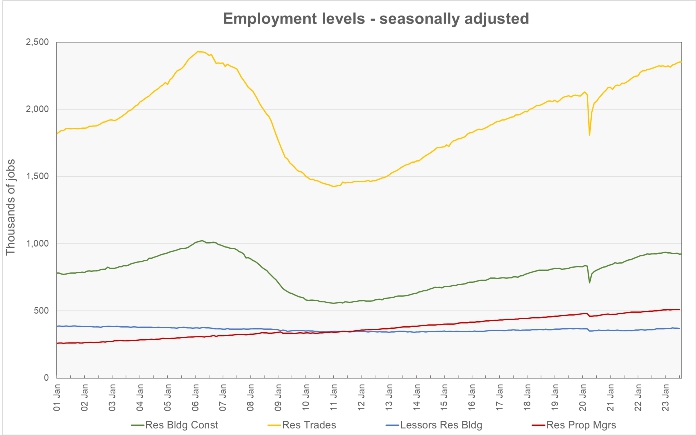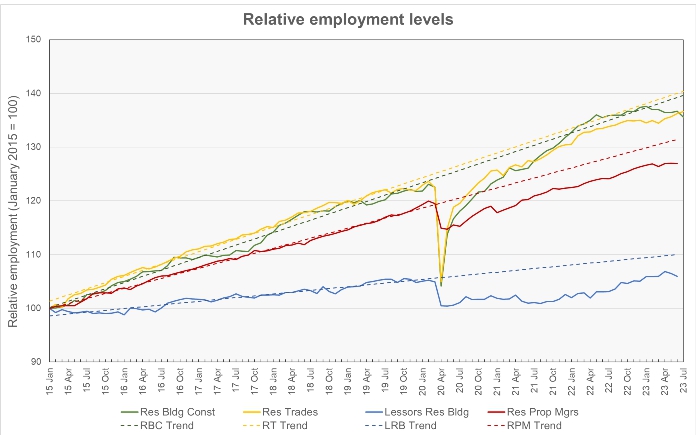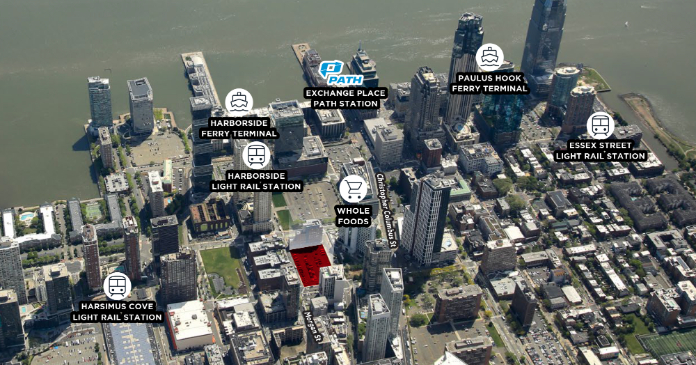The Employment Situation Report from the Bureau of Labor Statistics stated that employment was up for the month in only 2 of the 4 multifamily-related job categories we track despite downward revisions to the prior month’s employment levels for all 4 job categories.
Employment revised lower
The Bureau of Labor Statistics (BLS) reported that total seasonally-adjusted non-farm employment increased by 187,000 jobs in August to 156,419,000 jobs, based on their survey of business establishments. This compares to revised employment gains of 157,000 jobs in July and 105,000 jobs in June. July job gains were revised lower in the latest report by 30,000 jobs while June gains were revised lower by 80,000 jobs. The latest revision to the June jobs figure comes on top of a downward revision of 24,000 jobs in last month’s report. June job gains are now said to be half of the level initially reported.
The BLS household survey reported that the US unemployment rate rose to 3.8 percent, up 0.3 percentage point from last month’s level. The household survey found that the number of employed persons rose by 222,000 from that reported last month to 161,484,000. The number of unemployed persons rose by 514,000 to 6,355,000.
The household survey also found that the number of people in the civilian labor force rose by 736,000 in August while the adult civilian population rose by 211,000. The labor force participation rate rose 0.2 percentage points to 62.8 percent. It had been at 63.4 percent before the pandemic. Recovering that 0.6 percent decline in the labor force participation rate would bring 1.6 million more people into the workforce.
Tracking multifamily employment
The BLS reported more detailed employment information on four job categories of interest to the multifamily industry. These are employment as residential construction workers, as specialty trades within residential construction, as residential property managers and as lessors of residential buildings. As usual, some of the data is reported with a month delay, so the latest figures for the latter two categories are for the month of July.
The first chart shows the long-term history of the levels of employment in these four jobs categories.

Residential construction employment lower but rising
Employment in residential building construction in August, usually with general contractors, was reported to be up by 2,400 jobs. However, this was after a downward revision of the prior month’s employment level by 2,300 jobs. The employment level for June was also revised lower by 500 jobs. Employment in this category is now 924,600 jobs, up less than 0.1 percent year-over-year but 10.4 percent higher than its level in February 2020.
Employment in residential building trades, i.e. plumbers, electricians, etc., in August was reported to be down by 1,000 jobs from July’s level. In addition, July’s employment level was revised downward by 10,300 jobs. Employment in this category is now 2,351,300 jobs, up 1.8 percent year-over-year and 10.5 percent above its level in February 2020.
Total June employment in these two categories of residential construction jobs combined is up less than 0.1 percent from the revised level of the month before and up 1.3 percent year-over-year. It is down 0.3 percent from the preliminary level for July contained in last month’s report. Residential construction employment is 10.4 percent above its level in February 2020.
Apartment operations jobs reported to rise
Employment for residential property managers in July was reported to be up by 1,600 jobs from its revised (-1,800 jobs) level for June to 510,600 jobs. Employment for residential property managers is up 2.6 percent year-over-year and is up from its February 2020 level by 6.1 percent.
Employment for lessors of residential buildings in July was reported to fall by 400 jobs from its revised (-2,100 jobs) level for June to 370,100 jobs. Employment in this category is up 2.6 percent year-over-year and is now 0.6 percent above its pre-pandemic level.
Total employment in these two categories of apartment operations jobs combined was reported to be up 0.1 percent from the revised level for last month. It is down 0.4 percent from the preliminary level for June contained in last month’s report. It is now 3.8 percent above its level in February 2020.
Growth remains below trend
The final chart, below, presents the employment data in a different format. It normalizes the employment levels in all four jobs categories to a reading of 100 for January 2015. It also provides trend lines for the growth in each of the categories of employment based on the period from January 2015 through February 2020.

The chart shows that employment levels in all four categories of jobs that we track are now well below their pre-pandemic trends. Employment in the two categories of apartment operations jobs seem to have established a new growth trend, although it is below the previous trend line. Recently, employment in residential building construction has fallen, not just relative to the previous trend, but also in absolute terms.
Residential building construction employment is now 2.9 percent below trend. Residential trades employment is now 3.0 percent below trend. Residential property managers employment is 3.4 percent below trend and lessors of residential buildings employment is also 3.9 percent below trend.
The numbers given in the Employment Situation report are seasonally adjusted and are subject to revision. It is common for small adjustments to be made in subsequent reports, particularly to the data for the most recent month. The current Employment Situation report can be found here.













